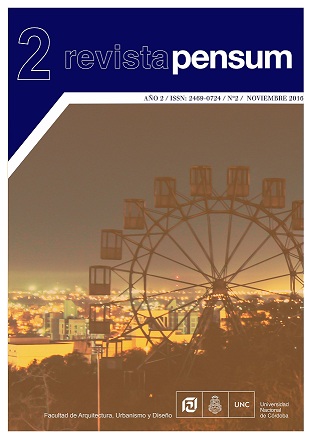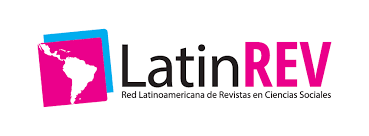Urban sound landscape “Soundwalk” as a method of integral analysis
DOI:
https://doi.org/10.59047/2469.0724.v2.n2.16431Keywords:
Soundscape, urban open space, sound perceptionAbstract
This research aims to deepen the study of variables that affect the acoustic perception of urban open spaces, the types of sound sources and the level of acceptance they produce on users, by means of acoustic and psychoacoustic descriptors. The obtained results allow verifying that the objective sounds levels on their own are not adequate indicators of the acoustic quality of an urban space. There are a number of variables that influence the urban acoustic features such as: the main developed activity and its relationship with the levels of perception of natural, human and technological sounds. The study of the acoustic quality of urban public spaces in the central area of Córdoba, when the objective acoustic conditions are similar, allows the analysis of the different reactions and degrees of users’ acceptance in outdoor spaces. The perspective also involves a comprehensive methodological development which takes into account the interaction among people, sound and context. A methodological approach is proposed for the analysis of the soundscape, based on a mechanical practice for objective evaluation, integrating and interrelating four acoustic descriptors selected: sound level, loudness, sharpness, the low frequency content, collected by applying the soundwalk as a research tool.Downloads
References
Adams M., Bruce N., Davies W., Cain R., Jennings P., Carlyle A., Cusack P., Hume K., Plack C. (2008). Soundwalking as methodology for understanding soundscapes. Proceedings of the Institute of Acoustics University of Salford, Salford, UK. Vol. 30. Pt.2.
Arana M., San Martín R., Nagore I., Pérez D., (2009). Using Noise Mapping to Evaluate the Percentage of People Affected by Noise. Acta Acustica United with Acustica, Vol. 95, pp 550-554.Berglund, 1995)
Carles, Jose Luis; Lopez Barrios, Isabel; de Lucio, Jose Vicente. (1999). “Sound influence on landscape values”. Landscape and Urban Planning 43 (1999) 191-200
Carles, J., López Barrio, I., (2007). Importance of Personal, Attitudinal and Contextual Variables in the Assessment of Pleasantness of The Urban Sound Environment. 19th International Congress on Acoustics (ICA). Madrid, Spain.
Chartier, F, Semidor C. (2005). Evaluation of Sound environment characteristics: comparative study between objective and subjective criteria, Proc. ASA/ CAA, Vancouver, Canada, 2005.
De Coensel, Bert; Botteldooren, Dick. (2006). The Quiet Rural Soundscape and How to Characterize it, ActaAcustica United with Acustica, Vol. 92, pp. 887 – 897.
Klaus Genuit, Klaus, Fiebig, André. (2006). Psychoacoustics and its Benefit for the Soundscape Approach. Acta Acustica United with Acustica Vol. 92.
Germán González, M., Santillán, A. (2006). Del Concepto de Ruido Urbano al de Paisaje Sonoro. Revista Bitácora Urbano Territorial, vol 1 Nº10. Universidad Nacional de Colombia, Bogotá.
Gjestland, T. (2002). “Current Research Topics and Problems: The Role of ICBEN”. Journal of Sound and Vibration, vol 250, Nº1.
Guastavino, C., (2006). The ideal urban soundscape: Investigating the sound quality of French cities. Acta Acustica united with Acustica, vol 92, pp 945-951.
Guillén, José Domingo; López Barrio, Isabel (2007): “The soundscape experience”. 19th International Congress on
Acoustics. Madrid, sep. 2007.
Kang J., Zhang M., 2010. Semantic differential analysis of the soundscape in urban open public spaces. Building and Environment, vol. 45, pp 150-157.
Keiper, Winfried (1997) Sound Quality Evaluation in the Product Cycle. Acta Acustica united with Acustica, Volume 83, Number 5, September /October 1997 , pp. 784-788(5)
Lee P. J., Jeon J. Y. (2008). Soundwalk for evaluating community noise annoyance in urban spaces. 9th International Congress on Noise as a Public Health Problem (ICBEN) 2008, Foxwoods, CT.
Llimpe C.E., Recuero M., Moreno J.N., (2006). Encuestas sobre molestias causadas por ruido en el Centro Historico de Lima, Perú: Analisis Subjetivo relacionado al estudio objetivo. V Congreso Iberoamericano de Acústica, Santiago, Chile.
Maristany A., Recuero López M. (2010). Relationship between objective and subjective indicators in urban soundscape analysis. The case of Córdoba – Argentina. Internoise 2010. Lisbon, Portugal.
Maristany A., Recuero López M., Asensio Rivera C. (2016). Soundscape quality analysis by fuzzy logic: A field study in Cordoba, Argentina. Applied Acoustics. Volume 111, October 2016, pp 106–115.
Nilsson, M.; Botteldooren, D.; De Coensel, B. (2007). Acoustic indicators of soundscape quality and noise annoyance in outdoor urban areas. 19th International Congress on Acoustics, Madrid, Spain, september 2007.
Nilsson. M. E. Jeon, J. Y. Rådsten-Ekman, M. Axelsson, Ö. (2012). A soundwalk study on the relationship between
soundscape and overall quality of urban outdoor places. Proceedings Acoustics 2012. Hong Kong.
Orfield, S.J. (1992) “A new paradigm in psychoacoustics, part five: sound quality metrics”. Sound & Communication. Dec 1992. Pp 68-78.
Pheasant R., Horoshenkov K., Watts G., Barrett B., (2008). The acoustic and visual factors influencing the construction of tranquil space in urban and rural environments tranquil spaces-quiet places?. Journal of Acoustic Society of America. 123 (3), March 2008. pp 1446–1457.
Quintero, Carolina; Recuero, Manuel. (2007). “Sound Environment Qualitative Assessment In The Streets Of Maracaibo – Venezuela. Soundscape”. 19th INTERNATIONAL CONGRESS ON ACOUSTICS MADRID, 2-7 SEPTEMBER 2007.
Raimbault M., Dubois D. (2005):“Urban soundscapes: Experiences and knowledge”. Cities, Vol. 22, No. 5, p. 339–350.
Raimbault, M.; Lavandier, C.; Berengier, (2003) M. Ambient sound assessment of urban environments: field studies in two French cities, Applied Acoustics, vol 64, pp. 1241–1256.
Raimbault, M.; Dubois, D. (2005). Urban soundscapes: Experiences and knowledge, Cities, Vol 22 (5), pp 339–350.
Recuero L. (1997). Mapas de ruido. Determinación del error cometido en medidas de campo, para diferentes duraciones de las Muestras. Revista de Acústica SEA, Vol 18 (3-4), pp 89-93.
Rychtarikova M., Vermeira G., Domeckac M. (2008).”The Application of the Soundscape Approach in the Evaluation of the Urban Public Spaces”. Acoustic ´08. Paris.
Schafer, R. Murray (1969). The New Soundscape. Don Mills.
Schulte-Fortkamp, B., (2007). Integrating the soundscape in the community noise area. 19th International Congress on Acoustics (ICA). Madrid, Spain.
Schulte-Fortkamp, Brigitte; Genuit, Klaus; Fiebig, André. (2007). “Perception of product sound quality and sound quality in soundscapes”. 19th International Congress on Acoustics. (ICA). Madrid, Spain.
Semidor, C.; Barlet, A.; Chartier, F. (2007). Soundscape approach as a tool for urban design. Second part: Frequentation, use and sound environment perception in four cities in Europe: Barcelona, Bristol, Brussels and Genoa, European Commission DG Research.
Semidor, Catherine. (2005). “Characterizaction of urban soundscape using psychoacoustic criteria”. Internoise 2005. Rio de Janeiro.
Sommerhoff J., Recuero M., Suarez E., 2004. Community noise survey of the city of Valdivia, Chile. Applied Acoustics, vol 65, pp 643–656.
Stasko -Mazur K. (2015). Soundwalk as a multifaceted practice. Argument: Biannual Philosophical Journal. ol. 5 (2/2015) pp. 439–455.
Suárez, E., Recuero, M. (2002). Metodologías Simplificadas para Estudios en Acústica Ambiental: Aplicación en la Isla de Menorca-Tesis Doctoral. Programa de Doctorado en Ingeniería Acústica, Departamento de Mecánica y Fabricación, E.T.S. de Ingenieros Industriales, Universidad Politécnica de Madrid, España.
Suárez E., Recuero M. (2000). Análisis Comparativo Sobre Programas Computacionales de Predicción de Ruido en
Exteriores. Memorias II Congreso Iberoamericano de Acústica, Tecniacústica 2000, Madrid, España.
Szeremeta B., Zannin P., (2009). Analysis and evaluation of soundscapes in public parks through interviews and
measurement of noise. Science of the Total Environment, 407, pp 6143-6149.
Venot, F., Sémidor, C. (2006). The “soundwalk” as an operational component for urban design. 23rd Conference on
Passive and Low Energy Architecture, Geneva, Switzerland. September 2006.
Viollon S.; Lavandier C.; Drake C., (2002). Influence of visual setting on sound ratings in an urban environment. Applied Acoustics, Volume 63, Number 5, pp 493-511.
Westerkamp, H. (1974). Soundwalking. Sound Heritage, Volume III Number 4, Victoria B.C. Revised 2001.
Yang, W, Kang, J (2005). “Acoustic comfort evaluation in urban open public spaces”. Applied Acoustics 66, pp 211-229.
Yu, Lei; Kang, Jian. (2008). “Effects of social, demographical and behavioral factors on the sound level evaluation in urban open spaces”. Journal of Acoustic Society of America. 123 (2), February 2008. pp 772-783.
Zannin P., Calixto A., Diniz F., Ferreira J., (2003). A survey of urban noise annoyance in a large Brazilian city: the importance of a subjective analysis in conjunction with an objective analysis. Environmental Impact Assessment Review, volume 23, pp 245-255.
Zhang, M.; Kang, J. (2007). Towards the evaluation, description, and creation of soundscapes in urban open spaces. Environment and Planning, vol 34, pp 68 - 86.
Downloads
Published
How to Cite
Issue
Section
License
Authors who publish in this journal agree to the following terms:
a. Authors retain copyright and guarantee to the journal the right to be the first publication of the work as well as licensed under a Creative Commons Attribution-ShareAlike 4 license.
b. Authors may separately establish additional agreements for non-exclusive distribution of the version of the work published in the journal (e.g., placing it in an institutional repository or publishing it in a book), with an acknowledgement of its initial publication in this journal.
c. Authors are permitted and encouraged to disseminate their work electronically (e.g., in institutional repositories or on their own website) before and during the submission process, as this may result in productive exchanges, as well as earlier and greater citation of published work (See The Effect of Open Access).
d. 4.0 International Creative Commons Attribution-ShareAlike 4.0 License.












